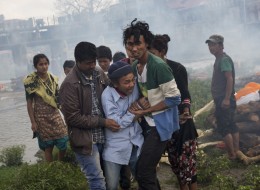gatekeeper
Loves the "Funny" Button
More devastation at slideshow at link - amazing in-progress falling of large building below, DailyMail pic link shows some of the damage in beautiful Buddhist city of Kathmandu.

DailyMail photos of ancient religious sites: http://www.dailymail.co.uk/news/article-3056248/Nepal-earthquake-Religious-sites-reduced-rubble.html

It is 24 hours after a 7.8 magnitude wreaked havoc on Nepal, and hundreds are still missing, countless are buried under the ruins as death toll rockets – more than 2, 500 as at Sunday, April 26.
In the country’s capital, Kathmandu, lifeless bodies of those recovered from the debris are laid on the streets, covered with white sheets as their relatives mourn and prepare them for mass cremation.
Nepal, known for its unique monumental structures and tourist sites, including Mount Everest, is a shadow of itself. The quake levelled the soil of the Asian nation, and with almost half of the people in it.
Rescue teams say dead bodies are recovered in more than quadruple on a per hour basis.
According to Dailymail, survivors are begging the international community for blood and relief materials to sustain the remaining population. Surgeons are said to have their hands full as they treat the wounded in tents – the country’s theatres are in ruins.
Newly-wed British couple, who were touring the Mount Everest site in Nepal when the quake triggered an avalanche that left 18 climbers dead, recount ordeal.
Revert to Pulse previous reports on the disastrous earthquake here and here.
DailyMail photos of ancient religious sites: http://www.dailymail.co.uk/news/article-3056248/Nepal-earthquake-Religious-sites-reduced-rubble.html
Last edited:


